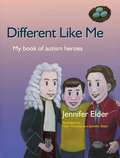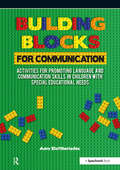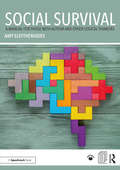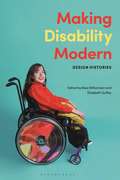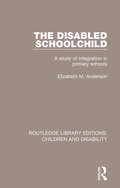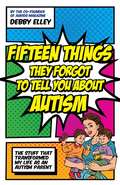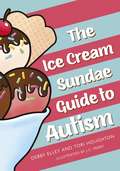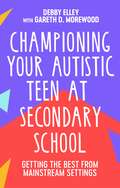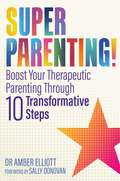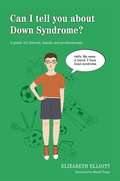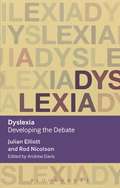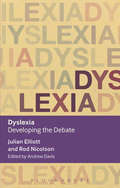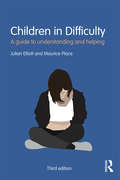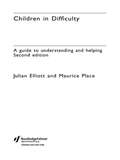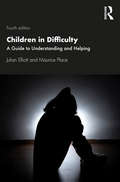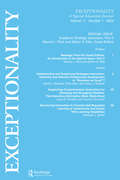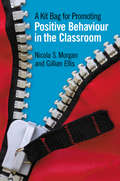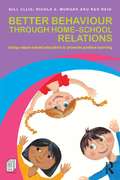- Table View
- List View
Different Like Me: My Book of Autism Heroes (PDF)
by Jennifer Elder Marc ThomasDifferent Like Me introduces children aged 8 to 12 years to famous, inspirational figures from the world of science, art, math, literature, philosophy and comedy. Eight-year-old Quinn, a young boy with Asperger's Syndrome, tells young readers about the achievements and characteristics of his autism heroes, from Albert Einstein, Dian Fossey and Wassily Kandinsky to Lewis Carroll, Benjamin Banneker and Julia Bowman Robinson, among others. All excel in different fields, but are united by the fact that they often found it difficult to fit in-just like Quinn. Fully illustrated in colour and written in child-friendly language, this book will be a wonderful resource for children, particularly children with autism, their parents, teachers, carers and siblings.
Building Blocks for Communication: Activities for Promoting Language and Communication Skills in Children with Special Educational Needs
by Amy EleftheriadesThis practical book provides school staff with lots of LEGO activities to use with children of all ages (5-16) to improve communication skills. Whether it is whole class doing group building activities to encourage collaborative working or paired work to target specific communication difficulties, this book is packed full of engaging, fun activities to suit all ages and abilities. LEGO never fails to entertain. Designed to look like play, each activity is structured to target the development of particular skills needed for successful learners, including many that focus on basic literacy and numeracy vocabulary.
Social Survival: A Manual For Those With Autism And Other Logical Thinkers
by Amy EleftheriadesSocial Survival is a practical manual outlining what it means to be a logical thinker and how logical thinkers can make sense of the social world. Relevant for young logical thinkers including those with high-functioning autism and Asperger’s syndrome, this book clearly outlines how social confusion might arise and how this can be overcome. Written in a clear and unpatronising style, the book considers a range of different social scenarios and breaks these down into manageable components with helpful activities to be completed by the young person. Chapters discuss the nature and benefits of logical thinking, nuances of language and communication in social situtations, and the intricacies of social etiquette and peer interaction. Features include: appealing visual resources; practical activities around social situations that are relevant to young people; blank templates which can be photocopied and are available for download online; guidance for family members on how to encourage ongoing communication; an action plan which can be personalised for different scenarios. Social Survival will be essential reading for health, social care and education professionals and parents working with those who have high functioning autism or Asperger’s syndrome or those who are logical thinkers who do not have a diagnosis. In addition, this book can be used independently by the young person themselves.
Social Survival: A Manual for those with Autism and Other Logical Thinkers
by Amy EleftheriadesSocial Survival is a practical manual outlining what it means to be a logical thinker and how logical thinkers can make sense of the social world. Relevant for young logical thinkers including those with high-functioning autism and Asperger’s syndrome, this book clearly outlines how social confusion might arise and how this can be overcome. Written in a clear and unpatronising style, the book considers a range of different social scenarios and breaks these down into manageable components with helpful activities to be completed by the young person. Chapters discuss the nature and benefits of logical thinking, nuances of language and communication in social situtations, and the intricacies of social etiquette and peer interaction. Features include: appealing visual resources; practical activities around social situations that are relevant to young people; blank templates which can be photocopied and are available for download online; guidance for family members on how to encourage ongoing communication; an action plan which can be personalised for different scenarios. Social Survival will be essential reading for health, social care and education professionals and parents working with those who have high functioning autism or Asperger’s syndrome or those who are logical thinkers who do not have a diagnosis. In addition, this book can be used independently by the young person themselves.
Making Disability Modern: Design Histories
by Elizabeth Guffeyand Bess WilliamsonMaking Disability Modern: Design Histories brings together leading scholars from a range of disciplinary and national perspectives to examine how designed objects and spaces contributes to the meanings of ability and disability from the late 18th century to the present day, and in homes, offices, and schools to realms of national and international politics. The contributors reveal the social role of objects - particularly those designed for use by people with disabilities, such as walking sticks, wheelchairs, and prosthetic limbs - and consider the active role that makers, users and designers take to reshape the material environment into a usable world. But it also aims to make clear that definitions of disability-and ability-are often shaped by design.
The Disabled Schoolchild: A Study of Integration in Primary Schools (Routledge Library Editions: Children and Disability)
by Anderson Elizabeth M.First published in 1973, this book considers the differences between mainstream schools and special educational needs schools, for children with learning disabilities. It contains a wealth of research data, case history material and reference to existing literature, designed to answer many questions which parents, heads, and schoolteachers have asked. Questions considered include whether children with disabilities do as well in ordinary schools as children without, whether they are as happy and well adjusted, and how they fit into the social structure of the class. The book also looks at whether much teasing occurs and how practical difficulties can be overcome.
The Disabled Schoolchild: A Study of Integration in Primary Schools (Routledge Library Editions: Children and Disability #2)
by Anderson Elizabeth M.First published in 1973, this book considers the differences between mainstream schools and special educational needs schools, for children with learning disabilities. It contains a wealth of research data, case history material and reference to existing literature, designed to answer many questions which parents, heads, and schoolteachers have asked. Questions considered include whether children with disabilities do as well in ordinary schools as children without, whether they are as happy and well adjusted, and how they fit into the social structure of the class. The book also looks at whether much teasing occurs and how practical difficulties can be overcome.
Fifteen Things They Forgot to Tell You About Autism: The Stuff That Transformed My Life as an Autism Parent
by Debby ElleyWhat if the things people need to know about autism is not the information they're getting? Combining myth-busting advice with personal experience, this book from the mother of autistic twins shares simple strategies to build children's confidence, communication, and independence. From sharing the joy of yodelling around shops at the weekend, to finding creative ways to communicate with both her verbal and her non-verbal sons, Debby Elley gives practical and fun tips for everyday living and shows that being autistic is just another way of being. Both witty and candid, the book discusses labels, meltdowns, acceptance, happiness and much more.
The Ice-Cream Sundae Guide to Autism: An Interactive Kids' Book for Understanding Autism
by Debby Elley Tori HoughtonAutism is a bit like an ice-cream sundae. There are lots of ingredients that go into it. There are so many types of sundae glasses out there. Some are plain and simple, some are loud and proud! In fact, sundae glasses are a bit like people - we're all different. Because we all have different personalities, autism doesn't look the same in everybody.This picture-led book uses ice-cream sundae ingredients to represent various aspects of autism such as sensory differences, special interests or rigidity of thinking, explaining the different facets of autism in a neutral way. The reader can create their own individual 'ice-cream sundae' to illustrate their personal strengths and challenges, highlighting how it makes them unique and helping to build confidence and self-awareness. It includes colourful illustrations and workbook activities to help children cement their understanding of autism.
Championing Your Autistic Teen at Secondary School: Getting the Best from Mainstream Settings
by Debby Elley Gareth D. MorewoodThe transition to secondary school can be a daunting time for parents of autistic youngsters, as well as children themselves. Have you selected the right place? What if staff don't really understand your child's needs? Will they adapt sufficiently - and if not, then what happens?The good news is that you have the ability as a parent or carer to address these concerns, rather than leaving it all to chance. This book will give you the tools to do just that. From choosing the right school for your child (and spotting the tell-tale signs of the wrong one), to preparing both your child and the new school for the transition, to overcoming barriers and building a positive, collaborative and effective relationship between home and school. Tackling key topics from the point of view of both parent and teacher and using examples of great practice, this contains everything you need to know in order to build a more positive secondary school experience for your child.
Superparenting!: Boost Your Therapeutic Parenting Through Ten Transformative Steps
by Amber ElliottTried nagging, shouting, taking away screen time, but with no success?Dr Amber Elliott explains why children who have experienced early trauma need something different - therapeutic parenting - a kind of everyday 'superparenting' which champions empathy over punishment.Trying to parent children who have trauma-triggered behaviours is tough, and none of us are perfect. Taking this as a starting point, Dr Elliott provides you with a ten-step process to transform your parenting. From developing self-acceptance and ideas for building motivation through to creative ways to think about structure and routine, the book combines principles with practical advice and exercises you can try out at home.Working together, you and your child can discover the secrets of superparenting and overcome trauma-triggered behaviours!
Superparenting!: Boost Your Therapeutic Parenting Through Ten Transformative Steps
by Amber ElliottTried nagging, shouting, taking away screen time, but with no success?Dr Amber Elliott explains why children who have experienced early trauma need something different - therapeutic parenting - a kind of everyday 'superparenting' which champions empathy over punishment.Trying to parent children who have trauma-triggered behaviours is tough, and none of us are perfect. Taking this as a starting point, Dr Elliott provides you with a ten-step process to transform your parenting. From developing self-acceptance and ideas for building motivation through to creative ways to think about structure and routine, the book combines principles with practical advice and exercises you can try out at home.Working together, you and your child can discover the secrets of superparenting and overcome trauma-triggered behaviours!
Can I tell you about Down Syndrome?: A guide for friends, family and professionals (PDF)
by Elizabeth Elliott Manjit ThappMeet David - a boy with Down syndrome. David invites readers to learn about Down syndrome from his perspective, helping them to understand what Down syndrome is and how it affects his daily life. He explains that he sometimes needs extra help at home and school and suggests ways that those around him can help him to feel supported. This illustrated book is ideal for young people aged 7 upwards, as well as parents, friends, teachers, social workers and other professionals working with children with Down syndrome. It is also an excellent starting point for family and classroom discussions.
Dyslexia: Developing the Debate (Key Debates in Educational Policy)
by Julian Elliott Rod Nicolson Andrew Davis Christopher WinchDyslexia is often presented as a clearly delineated condition that can be diagnosed on the basis of appropriate cognitive tests with corresponding forms on intervention. However, this approachable text explores the issues behind this assertion in bringing together leading figures in the field to debate dyslexia.Julian Elliott shows that understandings and usage of the dyslexia label vary substantially with little consensus or agreement and in putting forward his critique draws upon research in several disciplinary fields to demonstrate the irrationality of these arguments. Roderick I. Nicolson demonstrates that current approaches to understanding, identification and support of dyslexia are catastrophically flawed in terms of their failure to consider the developmental nature of dyslexia. He develops two themes: first that the underlying cause of dyslexia is 'delayed neural commitment' for skills and neural circuits, and second that the cause of the reading disability is the introduction of formal instruction before the dyslexic child's neural circuits for executive function are sufficiently developed. He argues that a more effective and cost-effective approach to identification and support involves 'assessment for dyslexia' rather than 'of dyslexia'. Elliott and Nicolson respond to the points each other raise before Andrew Davis investigates how far the key claims of Elliott and Nicolson can withstand close conceptual investigation, and explores the inherent limitations of scientific research on this topic, given the value and conceptual issues concerned.
Dyslexia: Developing the Debate (Key Debates in Educational Policy #14)
by Julian Elliott Rod Nicolson Andrew Davis Christopher WinchDyslexia is often presented as a clearly delineated condition that can be diagnosed on the basis of appropriate cognitive tests with corresponding forms on intervention. However, this approachable text explores the issues behind this assertion in bringing together leading figures in the field to debate dyslexia.Julian Elliott shows that understandings and usage of the dyslexia label vary substantially with little consensus or agreement and in putting forward his critique draws upon research in several disciplinary fields to demonstrate the irrationality of these arguments. Roderick I. Nicolson demonstrates that current approaches to understanding, identification and support of dyslexia are catastrophically flawed in terms of their failure to consider the developmental nature of dyslexia. He develops two themes: first that the underlying cause of dyslexia is 'delayed neural commitment' for skills and neural circuits, and second that the cause of the reading disability is the introduction of formal instruction before the dyslexic child's neural circuits for executive function are sufficiently developed. He argues that a more effective and cost-effective approach to identification and support involves 'assessment for dyslexia' rather than 'of dyslexia'. Elliott and Nicolson respond to the points each other raise before Andrew Davis investigates how far the key claims of Elliott and Nicolson can withstand close conceptual investigation, and explores the inherent limitations of scientific research on this topic, given the value and conceptual issues concerned.
Children in Difficulty: A guide to understanding and helping
by Julian Elliott Maurice PlaceWritten by two leading experts in the field, this welcome third edition of Children in Difficulty: A guide to understanding and helping discusses some of the most common, yet incapacitating, difficulties that are frequently encountered by young children and adolescents. This includes such topics as: ADHD disruptiveness and challenging behaviour in schools and classrooms dyslexia and reading disability eating disorders oppositional defiance, conduct and attachment disorders childhood depression school refusal developmental coordination disorder (dyspraxia) less common mental health problems, such as bipolar disorder and obsessive compulsive disorder. traumatic and stressful situations drug and solvent abuse. The third edition of this book includes brand new insights from the fields of genetics and neuroscience and ensures claims for the effectiveness of specific interventions are supported by rigorous, scientific evidence. By drawing upon high level scientific and clinical knowledge and distilling it in a way that is accessible to professionals from a range of child care disciplines, this book will be of significant value to those working in education, health or social care, and anyone who needs to be able to recognise and help children in difficulty.
Children in Difficulty: A guide to understanding and helping
by Julian Elliott Maurice PlaceWritten by two leading experts in the field, this welcome third edition of Children in Difficulty: A guide to understanding and helping discusses some of the most common, yet incapacitating, difficulties that are frequently encountered by young children and adolescents. This includes such topics as: ADHD disruptiveness and challenging behaviour in schools and classrooms dyslexia and reading disability eating disorders oppositional defiance, conduct and attachment disorders childhood depression school refusal developmental coordination disorder (dyspraxia) less common mental health problems, such as bipolar disorder and obsessive compulsive disorder. traumatic and stressful situations drug and solvent abuse. The third edition of this book includes brand new insights from the fields of genetics and neuroscience and ensures claims for the effectiveness of specific interventions are supported by rigorous, scientific evidence. By drawing upon high level scientific and clinical knowledge and distilling it in a way that is accessible to professionals from a range of child care disciplines, this book will be of significant value to those working in education, health or social care, and anyone who needs to be able to recognise and help children in difficulty.
Children in Difficulty: A guide to understanding and helping
by Julian Elliott Maurice PlaceWritten by two practising clinicians, this book is a guide for those who work with children. In clear, simple language it focuses upon some of the most common, yet often incapacitating, difficulties which are frequently encountered by young children and adolescents. After introducing and discussing different forms of therapy and treatment used in clinical work with children, the book focuses on a range of specific difficulties. Drawing upon recent research findings, and employing detailed case illustrations, it seeks to help the reader to understand the nature of each problem and offers a guide as to how the child in difficulty can best be helped. This new edition has been fully updated to include new material on conditions such as dyspraxia and ADHD. The authors also make full references to advances in the field of special education since the first edition was published, and provide a variety of sources for further reading and information. This practical book will be of particular value to those working in education, social work, health and child-care settings, and anyone else who needs to be able to recognise and help children in difficulty.
Children in Difficulty: A guide to understanding and helping
by Julian Elliott Maurice PlaceWritten by two practising clinicians, this book is a guide for those who work with children. In clear, simple language it focuses upon some of the most common, yet often incapacitating, difficulties which are frequently encountered by young children and adolescents. After introducing and discussing different forms of therapy and treatment used in clinical work with children, the book focuses on a range of specific difficulties. Drawing upon recent research findings, and employing detailed case illustrations, it seeks to help the reader to understand the nature of each problem and offers a guide as to how the child in difficulty can best be helped. This new edition has been fully updated to include new material on conditions such as dyspraxia and ADHD. The authors also make full references to advances in the field of special education since the first edition was published, and provide a variety of sources for further reading and information. This practical book will be of particular value to those working in education, social work, health and child-care settings, and anyone else who needs to be able to recognise and help children in difficulty.
Children in Difficulty: A Guide to Understanding and Helping
by Julian Elliott Maurice PlaceThis fully updated fourth edition of Children in Difficulty explores some of the most common, yet incapacitating, difficulties often encountered by young children and adolescents. Drawing on the latest research and with case studies throughout, chapters cover topics such as challenging behaviour and school refusal, eating disorders, anxiety and depression, substance misuse, neurodevelopmental disorders, dyslexia and dyspraxia. The book provides a deeper understanding of each difficulty, considering the complexities of each problem at depth and analysing the best forms of intervention. It includes insights from the fields of genetics and neuroscience, and ensures that claims for the effectiveness of specific interventions are supported by rigorous scientific evidence. Features of this new edition include: Up-to-date insights from the fields of psychology, genetics and neuroscience Recognition of the increasing impact of social media and the internet on children and young people. Written by experts in the field, this book distils high level scientific and clinical knowledge in a way that is accessible to professionals from a range of child-care disciplines. It will be of significant value to those working in education, health or social care, and anyone who needs to be able to recognise and help children in difficulty.
Children in Difficulty: A Guide to Understanding and Helping
by Julian Elliott Maurice PlaceThis fully updated fourth edition of Children in Difficulty explores some of the most common, yet incapacitating, difficulties often encountered by young children and adolescents. Drawing on the latest research and with case studies throughout, chapters cover topics such as challenging behaviour and school refusal, eating disorders, anxiety and depression, substance misuse, neurodevelopmental disorders, dyslexia and dyspraxia. The book provides a deeper understanding of each difficulty, considering the complexities of each problem at depth and analysing the best forms of intervention. It includes insights from the fields of genetics and neuroscience, and ensures that claims for the effectiveness of specific interventions are supported by rigorous scientific evidence. Features of this new edition include: Up-to-date insights from the fields of psychology, genetics and neuroscience Recognition of the increasing impact of social media and the internet on children and young people. Written by experts in the field, this book distils high level scientific and clinical knowledge in a way that is accessible to professionals from a range of child-care disciplines. It will be of significant value to those working in education, health or social care, and anyone who needs to be able to recognise and help children in difficulty.
Academic Strategy Instruction: A Special Issue of Exceptionality
by Edwin S. Ellis Marcia L. RockThis special issue, Part II in a series devoted to the topic of strategic instruction, explores the issue of traversing the research to practice abyss through the implementation of authentic and effective business development. It reminds us that "business as usual" approaches to teacher in-service programs are unlikely to produce meaningful changes in teachers' classroom practices. In addition, this issue offers strategic instructional approaches to facilitate students' learning and focuses on structuring instruction to promote self-regulated learning. Each article raises important questions about existing practices and offers innovative alternatives to improve outcomes for students and teachers.
A Kit Bag for Promoting Positive Behaviour in the Classroom (PDF)
by Gill Ellis Nicola MorganDisruptive classroom behaviours can prevent effective teaching and create a negative learning environment. This handy directory of behaviours has been written by teachers for teachers, and is bursting with tried and tested techniques to make the classroom a happier and more productive place for everyone. The 'Kit Bag' is a bank of up-to-date ideas that can be dipped into whenever needed, each one intended to get children focused and more engaged and excited by the learning process. The book suggests ways to create a positive learning environment in the classroom and encourages teachers to be proactive at the most vulnerable times of the school day such as at the start and end of lessons. Strategies are included for addressing behaviour hotspots, such as calling out, frequent crying or aggressive behaviour, as well as how to uncover the source of these problems and practical ways to prevent them from reoccurring. The useful Self-Assessment Checklist will also aid in making sure teachers are constructively reinforcing positive behaviour at all times. This widely acclaimed approach will be a must for any teacher who has ever been confronted with challenging behaviour and wants to get the best out of their pupils. It will also be a valuable tool for headteachers and senior leaders who want to revolutionise current school practices.
Better Behaviour through Home-School Relations: Using values-based education to promote positive learning
by Gill Ellis Nicola S. Morgan Ken ReidHow can we create effective partnerships between home, school and the community? How can the relationships and communication between families and school be strengthened? How can families help schools to improve behaviour in their children, both at home and at school? Using a tried and tested framework that has been successfully implemented throughout a wide variety of very different schools and settings, ‘Family Values’ is a Scheme which engages and empowers families to work in close collaboration with schools and organisations, and which results in long-term improvements in behaviour, communication, pupil achievement and relationships. The ‘Family Values’ Scheme has been proven to: Help pupils to be more academically diligent Help schools to assume a calmer, more peaceful ambience Forge better pupil-teacher relationships Improve Pupil and teacher wellbeing Help parents to be more engaged with the school Improve children’s literacy, behaviour and attendance Provide head teachers and their staff with an effective whole-school strategy. The authors’ award-winning ‘Family Values’ Scheme is underpinned by sound theoretical principles, and they show here how it has been successfully put into practice through case studies in real school settings. The book explores how the Scheme promotes social, emotional and family system theories, and, in linking effectively to SEAL (social and emotional aspects of learning), the Scheme compliments existing personal and social education programmes in all schools. Showing schools and organisations how to create effective partnerships with families and the community in a fun, exciting and sustainable way, Better Behaviour through Home-School Relations will be of huge benefit to all school staff, as well as local authorities, support groups, parents, charities and services.
Better Behaviour through Home-School Relations: Using values-based education to promote positive learning
by Gill Ellis Nicola S. Morgan Ken ReidHow can we create effective partnerships between home, school and the community? How can the relationships and communication between families and school be strengthened? How can families help schools to improve behaviour in their children, both at home and at school? Using a tried and tested framework that has been successfully implemented throughout a wide variety of very different schools and settings, ‘Family Values’ is a Scheme which engages and empowers families to work in close collaboration with schools and organisations, and which results in long-term improvements in behaviour, communication, pupil achievement and relationships. The ‘Family Values’ Scheme has been proven to: Help pupils to be more academically diligent Help schools to assume a calmer, more peaceful ambience Forge better pupil-teacher relationships Improve Pupil and teacher wellbeing Help parents to be more engaged with the school Improve children’s literacy, behaviour and attendance Provide head teachers and their staff with an effective whole-school strategy. The authors’ award-winning ‘Family Values’ Scheme is underpinned by sound theoretical principles, and they show here how it has been successfully put into practice through case studies in real school settings. The book explores how the Scheme promotes social, emotional and family system theories, and, in linking effectively to SEAL (social and emotional aspects of learning), the Scheme compliments existing personal and social education programmes in all schools. Showing schools and organisations how to create effective partnerships with families and the community in a fun, exciting and sustainable way, Better Behaviour through Home-School Relations will be of huge benefit to all school staff, as well as local authorities, support groups, parents, charities and services.
